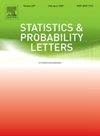Fractional signature: A generalisation of the signature inspired by fractional calculus
IF 0.7
4区 数学
Q3 STATISTICS & PROBABILITY
引用次数: 0
Abstract
In this paper, we propose a novel generalisation of the signature of a path, motivated by fractional calculus, which is able to describe the solutions of linear Caputo controlled FDEs. We also propose another generalisation of the signature, inspired by the previous one, but more convenient to use in machine learning. Finally, we test this last signature in a toy application to the problem of handwritten digit recognition, where significant improvements in accuracy rates are observed compared to those of the original signature.
分数签名:由分数微积分启发的签名的推广
在本文中,我们提出了一种新的由分数阶微积分驱动的路径签名的推广,它能够描述线性Caputo控制的FDEs的解。我们还提出了签名的另一种推广,受前一种的启发,但更便于在机器学习中使用。最后,我们在一个玩具应用程序中测试了最后一个签名,以解决手写数字识别问题,与原始签名相比,准确率有了显着提高。
本文章由计算机程序翻译,如有差异,请以英文原文为准。
求助全文
约1分钟内获得全文
求助全文
来源期刊

Statistics & Probability Letters
数学-统计学与概率论
CiteScore
1.60
自引率
0.00%
发文量
173
审稿时长
6 months
期刊介绍:
Statistics & Probability Letters adopts a novel and highly innovative approach to the publication of research findings in statistics and probability. It features concise articles, rapid publication and broad coverage of the statistics and probability literature.
Statistics & Probability Letters is a refereed journal. Articles will be limited to six journal pages (13 double-space typed pages) including references and figures. Apart from the six-page limitation, originality, quality and clarity will be the criteria for choosing the material to be published in Statistics & Probability Letters. Every attempt will be made to provide the first review of a submitted manuscript within three months of submission.
The proliferation of literature and long publication delays have made it difficult for researchers and practitioners to keep up with new developments outside of, or even within, their specialization. The aim of Statistics & Probability Letters is to help to alleviate this problem. Concise communications (letters) allow readers to quickly and easily digest large amounts of material and to stay up-to-date with developments in all areas of statistics and probability.
The mainstream of Letters will focus on new statistical methods, theoretical results, and innovative applications of statistics and probability to other scientific disciplines. Key results and central ideas must be presented in a clear and concise manner. These results may be part of a larger study that the author will submit at a later time as a full length paper to SPL or to another journal. Theory and methodology may be published with proofs omitted, or only sketched, but only if sufficient support material is provided so that the findings can be verified. Empirical and computational results that are of significant value will be published.
 求助内容:
求助内容: 应助结果提醒方式:
应助结果提醒方式:


